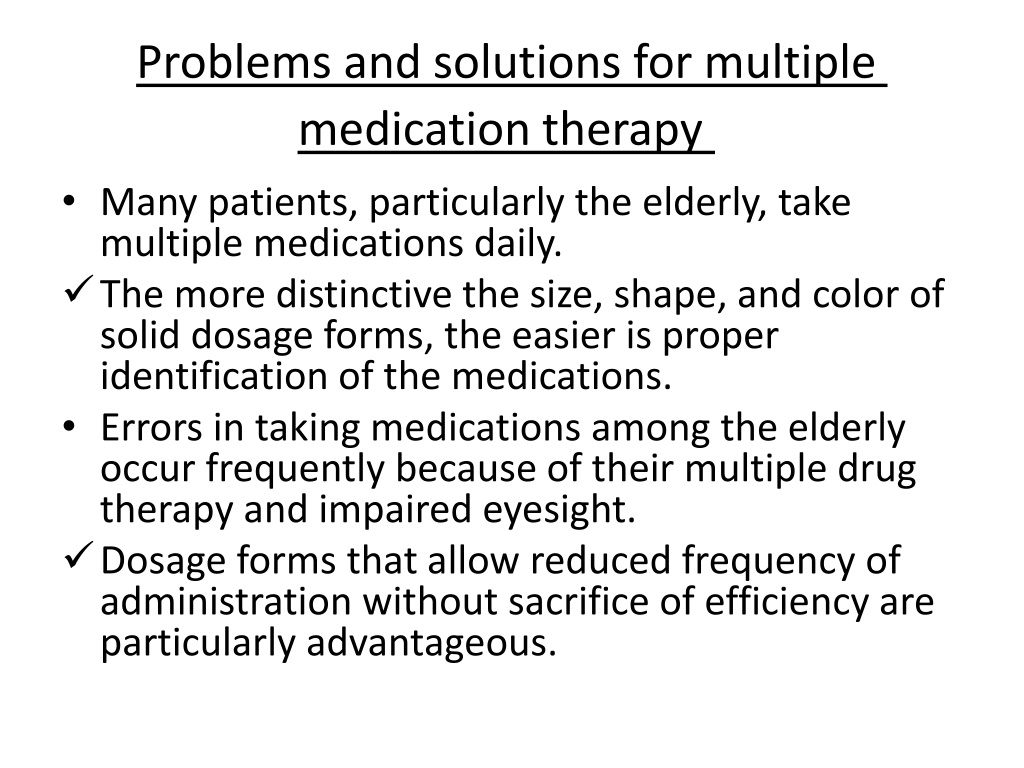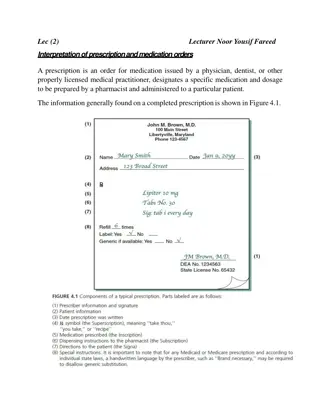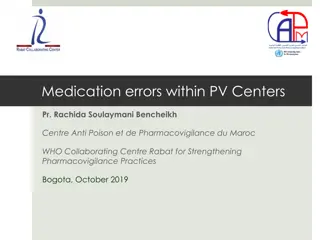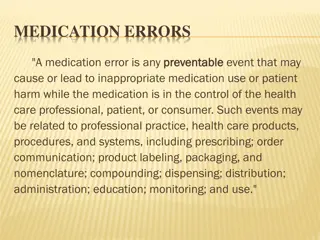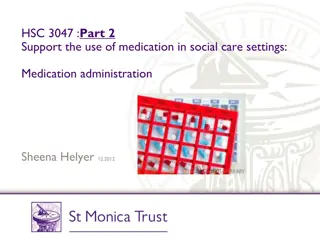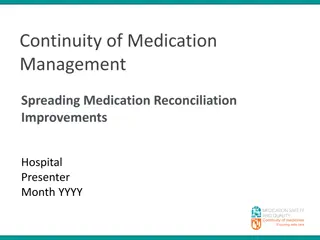Understanding Medication Therapy: Problems and Solutions
Many patients, especially the elderly, face challenges with multiple medication therapy due to impaired eyesight and complex drug regimens. Proper identification of medications is key, with distinct sizes, shapes, and colors aiding in differentiation. Performing formulation studies before developing dosage forms is essential to ensure the chemical, physical, and biologic properties of the drug are optimal. Various drug forms like liquids present design challenges but offer unique therapeutic benefits. Examples such as amyl nitrate and propylhexedrine showcase the considerations in handling volatile liquid medications.
Download Presentation

Please find below an Image/Link to download the presentation.
The content on the website is provided AS IS for your information and personal use only. It may not be sold, licensed, or shared on other websites without obtaining consent from the author. Download presentation by click this link. If you encounter any issues during the download, it is possible that the publisher has removed the file from their server.
E N D
Presentation Transcript
Problems and solutions for multiple medication therapy Many patients, particularly the elderly, take multiple medications daily. The more distinctive the size, shape, and color of solid dosage forms, the easier is proper identification of the medications. Errors in taking medications among the elderly occur frequently because of their multiple drug therapy and impaired eyesight. Dosage forms that allow reduced frequency of administration without sacrifice of efficiency are particularly advantageous.
Performulation Studies Before the formulation of a drug substance into a dosage form, it is essential that it be chemically and physically characterized. Physical Description It is important to understand the physical description of a drug substance prior to dosage form development. Most drug substances in use today are solid materials, pure chemical compounds of either crystalline or amorphous constitution. The purity of the chemical substance is essential for its identification and for evaluation of its chemical, physical, and biologic properties.
Chemical properties include structure, form, and reactivity. Physical properties include such characteristics as its physical description, particle size, crystalline structure, melting point, and solubility. Biologic properties relate to its ability to get to a site of action and elicit a biologic response.
Drugs can be used therapeutically as solids, liquids, and gases. Liquid drugs are used to a much lesser extent than solid drugs; gases, even less frequently. Liquid drugs pose an interesting problem in design of dosage forms and delivery systems. 1. Many liquids are volatile and must be physically sealed from atmosphere to prevent evaporation loss.
Examples Amyl nitrate, for example, is clear yellowish liquid that is volatile even at low temperatures and is also highly flammable. It is kept for medicinal purposes in small sealed glass cylinders wrapped with gauze or another suitable material. When amyl nitrite is administered, the glass is broken between the fingertips, and the liquid wets the gauze covering, producing vapors that are inhaled by the patient requiring vasodilation.
Examples Propylhexedrine is another volatile liquid that must be contained in a closed system. This drug is used as a nasal inhalant for its vasoconstrictor action. A cylinder roll of fibrous material is impregnated with propylhexedrine, and the saturated cylinder is placed in a suitable, usually plastic, sealed nasal inhaler. The inhaler's cap must be securely tightened each time it is used. Even then, the inhaler maintains its effectiveness for only a limited time because of the volatility of the drug.
2. Another problem associated with liquid drugs is that those intended for oral administration cannot generally be formulated into tablet form, the most popular form of oral medication. An exception to this is the liquid drug nitroglycerin, which is formulated into sublingual tablets that disintegrate within seconds after replacement under the tongue. However, because the drug is volatile, it has a tendency to escape from the tablets during storage, and it is critical that the tablets be stored in a tightly sealed glass container.
Approaches For the most part, when a liquid drug is to be administered orally and a solid form is desired, one of two approaches is used. First, the liquid substance may be sealed in a soft gelatine capsule. Vitamins A, D, and E, cyclosporine and ergoloid mesylates are liquids commercially available in capsule form. Second, the liquid drug may be developed into a solid ester or salt form that will be suitable for tablets or drug capsules. For instance, scopolamine Hydrobromide is a solid salt of the liquid drug scopolamine and is easily pressed into tablets.
Another approach to formulate liquids into solids is by mixing the drug with a solid or melted semisolid material, such as a high- molecular-weight polyethylene glycol. The melted mixture is poured into hard gelatine capsules to harden and the capsules sealed.
Advantages of liquid drugs For certain liquid drugs, especially those taken orally in large doses or applied topically, their liquid nature may have some advantage in the therapy. For example, 15-mL doses of mineral oil may be administered conveniently as such. Also, the liquid nature of undecylenic acid certainly does not hinder but rather enhances its use topically in the treatment of fungus infections of the skin, however, for the most part, pharmacists prefer solid materials in formulation work because they can easily form them into tablets and capsules.
Why solid dosage forms are preferred ? Formulation and stability difficulties arise less frequently with solid dosage form than with liquid preparations, and for this reason many new drugs first reach the market as tablet or dry-filled capsules. Later, when the pharmaceutical problems are resolved, a liquid form of the same drug may be marked. This procedure is doubly advantageous, because for the most part physicians and patients alike prefer small, generally tasteless, accurately dosed tablets or capsules to the analogous liquid forms. Therefore, marketing a drug in solid form first is more practical for the manufacturer and suits most patients. It is estimated that tablets and capsules constitute the dosage form dispensed 70% of the time by community pharmacists, with tablets dispensed twice as frequently as capsules.
Heat of vaporization The use of vapor pressure is important in the following situations: 1. The operation of implantable pumps delivering medication 2. Aerosol dosage forms 3. The use of nasal inhalants (propylhexedrine with menthol and lavender oil-benzedrex) or treating nasal congestion. 4. Some volatile drugs can even migrate within a tablet dosage form so the distribution may not be uniform any longer. This may have an impact in tablet that are scored for dosing where the drug in one portion may be higher or lower than in the other portion. 5. Exposure of personal to hazardous drugs due to handling, spilling, or aerosolizing of the drugs that may vaporize (oncology agents) is another application as the increase in mobility of the hazardous drug molecules may be related to temperature of the environment. 6. Some drugs, such as carmustine, experience greater vapor pressures with increased temperature as compared to cyclophosphamide, etoposide, cisplatin, and 5-fluorouracil).
Melting point Depression A characteristic of a pure substance is a defined melting point or melting range. If not pure, the substance will exhibit a change in melting point. (A pure chemical is ordinarily characterised by a very sharp melting peak). This phenomenon is commonly used to determine the purity of a drug substance and in some cases the compatibility of various substances before inclusion in the same dosage form.
The Phase Rule Phase diagrams are often constructed to provide a visual picture of the existence and extent of the presence of solid and liquid phases in binary, ternary, and other mixtures.
Particle Size Certain physical and chemical properties of drug substances, including dissolution rate, bioavailability, content uniformity, taste, texture, color, and stability, are affected by the particle size distribution. In addition, flow characteristics and sedimentation rates, among other properties, are important factors related to particle size. It is essential to establish as early as possible how the particle size of the drug substance may affect formulation and efficacy of special interest is the effect of particle size on absorption. Particle size significantly influences the oral absorption profiles of certain drugs, including griseofulvin, nitofurantoin, spironolactone, and procaine penicillin. Also, satisfactory content uniformity in solid dosage forms depends to a large degree on particle size and the equal distribution of the active ingredient throughout the formulation. Particle size is analysed using special instrument like Mastersizer 2000E particle size analyzer
Polymorphism An important factor on formulation is the crystal or amorphous form of the drug substance. Polymorphic forms usually exhibit different physicochemical properties, including melting point and solubility. Polymorphic forms in drugs are relatively common. It has been estimated that at least one third of all organic compounds exhibit polymorphism. In addition to polymorphic forms, compounds may occur in noncrystalline or amorphous forms. The energy required for a molecule of drug to escape from a crystal is much greater than is required to escape from an amorphous powder, therefore, the amorphous form of a compound is always more soluble than a corresponding crystal form.
Evaluation of crystal structure, polymorphism, and solvate form is an important performulation activity. The changes in crystal characteristics can influence bioavailability and chemical and physical stability and can have important implications in dosage form process functions. For example, it can be a significant factor relating to tablet formation because of flow and compaction behaviours, among others. Various techniques are used to determine crystal properties. The most widely used methods are hot stage microscopy, thermal analysis, infrared spectroscopy, and X-ray diffraction.
Solubility An important physicochemical property of a drug substance is solubility, especially aqueous system solubility. A drug must possess some aqueous solubility for therapeutic efficacy. For a drug to enter the systemic circulation and exert a therapeutic effect, it must first be in solution. Relatively insoluble compounds often exhibit incomplete or erratic absorption. If the solubility of the drug substance is less than desirable, consideration must be must be given to improve its solubility. The methods to accomplish this depend on the chemical nature of the drug and the type of drug product under consideration. Chemical modification of the drug into salt or ester forms is frequently used to increase solubility.
A drug's solubility is usually determined by the equilibrium solubility method, by which excess of the drug is placed in a solvent and shaken at a constant temperature over a long period until equilibrium is obtained. Chemical analysis of the drug content in solution is performed to determine degree of solubility.
Solubility and Particle Size Although solubility is normally considered a physicochemical constant, small increase in solubility can be accomplished by particle size reduction Solubility and pH Another technique, if the drug is to be formulated into a liquid product, is adjustment of the pH of the solvent to enhance solubility. However, for many drug substances pH adjustment is not an effective means of improving solubility. Weak acidic or basic drugs may require extremes in pH that are outside accepted physiologic limits or that may cause stability problems with formulation ingredients. Adjustment of the pH usually has little effect on the solubility of substances other than electrolytes. In many cases, it is desirable to use cosolvents or other techniques such as complexation, or solid dispersion to improve aqueous solubility.
